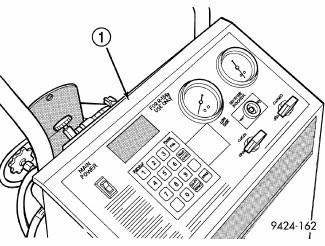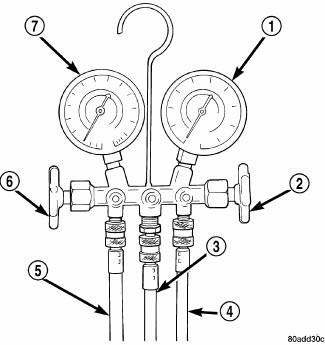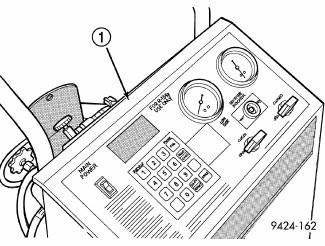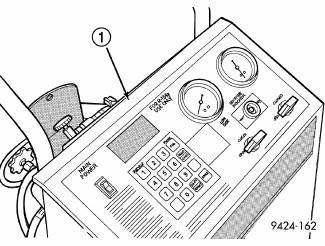Dodge Journey: Standard procedure
REFRIGERANT SYSTEM SERVICE EQUIPMENT
WARNING: Refer to the applicable warnings and cautions for this system before performing the following operation. Failure to follow these instructions may result in serious or fatal injury.
WARNING: Eye protection must be worn when servicing an air conditioning refrigerant system. Turn off (rotate clockwise) all valves on the equipment being used, before connecting to or disconnecting from the refrigerant system. Failure to observe these warnings may result in serious or fatal injury.

Fig. 196: Refrigerant Recovery/Recycling Station - Typical
When servicing the A/C system, a R-134a refrigerant recovery/recycling/charging station that meets SAE standard J2788 must be used (1). Per SAE standard J2788, refrigerant recovery stations must recover 95% of the refrigerant system within 30 minutes at 21.1 degrees C (70 degrees F) and be able to measure the amount of refrigerant removed from the system to an accuracy of 28 grams (1 oz.). When charging, the refrigerant recovery station must charge the system to an accuracy of 14 grams (0.5 oz.). Contact an automotive service equipment supplier for refrigerant recovery/recycling/charging equipment. Refer to the operating instructions supplied by the equipment manufacturer for proper care and use of this equipment.

Fig. 197: Manifold Gauge Set - Typical
A manifold gauge set (1) may be needed with some recovery/recycling/charging equipment. The manifold gauge set should have manual shut-off valves (2 and 6), or automatic back-flow valves located at the service port connector end of the manifold gauge set hoses (4 and 5). This will prevent refrigerant from being released into the atmosphere.
MANIFOLD GAUGE SET CONNECTIONS
CAUTION: Do not use an R-12 manifold gauge set on an R-134a system. The refrigerants are not compatible and A/C system damage will result.
- LOW PRESSURE GAUGE HOSE - The low pressure hose (Blue with Black stripe) attaches to the low side service port. This port is located on the A/C suction line near the dash panel.
- HIGH PRESSURE GAUGE HOSE - The high pressure hose (Red with Black stripe) attaches to the high side service port. This port is located on the A/C liquid line near the right front strut tower.
- RECOVERY/RECYCLING/EVACUATION/CHARGING HOSE - The center manifold hose
(Yellow, or White, with Black stripe) is used to recover, evacuate, and
charge the refrigerant system.
When the low or high pressure valves on the manifold gauge set are opened, the refrigerant in the system will escape through this hose.
REFRIGERANT SYSTEM RECOVERY
WARNING: Refer to the applicable warnings and cautions for this system before performing the following operation. Failure to follow these instructions may result in serious or fatal injury.

Fig. 198: Identifying R-134A Refrigerant Recovery/Recycling/Charging Station
NOTE: If equipped with the rear heating-A/C system, use a heat gun to heat the underbody lines to help remove any trapped refrigerant from the rear A/C system.
When servicing the A/C system, a R-134a refrigerant recovery/recycling/charging station that meets SAE standard J2788 must be used (1). Per SAE standard J2788, refrigerant recovery stations must recover 95% of the refrigerant system within 30 minutes at 21.1 degrees C (70 degrees F) and be able to measure the amount of refrigerant removed from the system to an accuracy of 28 grams (1 oz.). Refer to the operating instructions supplied by the equipment manufacturer for proper care and use of this equipment.
REFRIGERANT SYSTEM EVACUATE
CAUTION: Do NOT run the engine with a vacuum pump in operation or with a vacuum present within the A/C system. Failure to follow this caution will result in serious A/C compressor damage.
NOTE: Special effort must be used to prevent moisture from entering the A/C system oil. Moisture in the oil is very difficult to remove and will cause a reliability problem with the A/C compressor.
If an A/C compressor designed to use R-134a refrigerant is left open to the atmosphere for an extended period of time. It is recommended that the refrigerant oil be drained and replaced with new oil or a new A/C compressor be used. This will eliminate the possibility of contaminating the refrigerant system.
If the refrigerant system has been open to the atmosphere, it must be evacuated before the system can be filled.
Moisture and air mixed with the refrigerant will raise the compressor head pressure above acceptable operating levels. This will reduce the performance of the A/C system and damage the A/C compressor. Moisture will boil at near room temperature when exposed to vacuum. To evacuate the refrigerant system:
NOTE: When connecting the service equipment coupling to the line fitting, verify that the valve of the coupling is fully closed. This will reduce the amount of effort required to make the connection.
1. Recover the refrigerant system.
2. With the engine OFF, connect a suitable charging station, refrigerant recovery machine or a manifold gauge set with vacuum pump and refrigerant recovery equipment. Do not operate the engine with a vacuum on the A/C system.
3. Open the suction and discharge valves and start the vacuum pump. The vacuum pump should run a minimum of 45 minutes prior to charge to eliminate all moisture in system. When the suction gauge reads to the lowest degree of vacuum possible (approximately -88 kPa (- 26 in. Hg) or greater) for 30 minutes, close all valves and turn off vacuum pump. If the system fails to reach specified vacuum, the refrigerant system likely has a leak that must be corrected. If the refrigerant system maintains specified vacuum for at least 30 minutes, start the vacuum pump, open the suction and discharge valves. Then allow the system to evacuate an additional 10 minutes.
4. Close all valves. Turn off and disconnect the vacuum pump.
5. Charge the refrigerant system.
REFRIGERANT SYSTEM CHARGE
WARNING: Review safety precautions and warnings in this part before performing this procedure. Failure to follow these instructions may result in serious or fatal injury.
NOTE: The Underhood HVAC Specification Label contains the refrigerant fill specification of the vehicle being serviced.

Fig. 199: Identifying R-134A Refrigerant Recovery/Recycling/Charging Station
After all refrigerant system leaks have been repaired and the refrigerant system has been evacuated, a refrigerant charge can be injected into the system. When charging the A/C system, a R-134a refrigerant recovery/recycling/charging station that meets SAE standard J2788 must be used (1). Per SAE standard J2788, refrigerant recovery stations must charge the system to an accuracy of 14 grams (0.5 oz.). Refer to the operating instructions supplied by the equipment manufacturer for proper care and use of this equipment.
CHARGING PROCEDURE
CAUTION: A small amount of refrigerant oil is removed from the A/C system each time the refrigerant system is recovered and evacuated. Before charging the A/C system, you MUST replenish any oil lost during the recovery process. See the equipment manufacturer instructions for more information.
1. Evacuate the refrigerant system. 2. Connect a manifold gauge set or R-134a refrigerant recovery/recycling/charging station that meets SAE standard J2788 to the refrigerant system.
3. Measure the proper amount of refrigerant and heat it to 52º C (125º F) with the charging station. See the operating instructions supplied by the equipment manufacturer for proper use of this equipment.
4. Open both the suction and discharge valves, then open the charge valve to allow the heated refrigerant to flow into the system.
5. When the transfer of refrigerant has stopped, close both the suction and discharge valves.
6. If all of the refrigerant charge did not transfer from the dispensing device, open all of the windows in the vehicle and set the heating-A/C system controls so that the A/C compressor is engaged and the blower motor is operating at its lowest speed setting. Run the engine at a steady high idle (about 1400 rpm). If the A/C compressor does not engage, test the compressor clutch control circuit and repair as required.
7. Open the low-side valve to allow the remaining refrigerant to transfer to the refrigerant system.
WARNING: Take care not to open the discharge (high pressure) valve at this time. Failure to follow this warning could result in possible serious or fatal injury.
8. Disconnect the charging station and manifold gauge set from the refrigerant system service ports.
9. Reinstall the caps onto the refrigerant system service ports.
 Diagnosis and Testing
Diagnosis and Testing
REFRIGERANT SYSTEM LEAKS
WARNING: R-134a service equipment or vehicle A/C system should not
be pressure
tested or leak tested with compressed air. Mixture of air and R-134a can
be co ...
 Compressor, A/C
Compressor, A/C
...
See also:
Actuator, mode door, front
DESCRIPTION
Fig. 12: Blend Door Actuators
The mode door actuator (1) for the heating-A/C system is a reversible,
12-volt Direct Current (DC) servo motor,
which is mechanically connected to the ...
Ring(s), piston
Standard Procedure
PISTON RING FITTING
Fig. 200: CHECK GAP ON PISTON RINGS
- FEELER GAUGE
1. Wipe cylinder bore clean. Insert ring and push down with piston to ensure
it is square in bore ...
Manifold, intake
Diagnosis and Testing
INTAKE MANIFOLD LEAKS
An intake manifold air leak is characterized by lower than normal manifold
vacuum. Also, one or more
cylinders may not be functioning.
WARNING: ...
